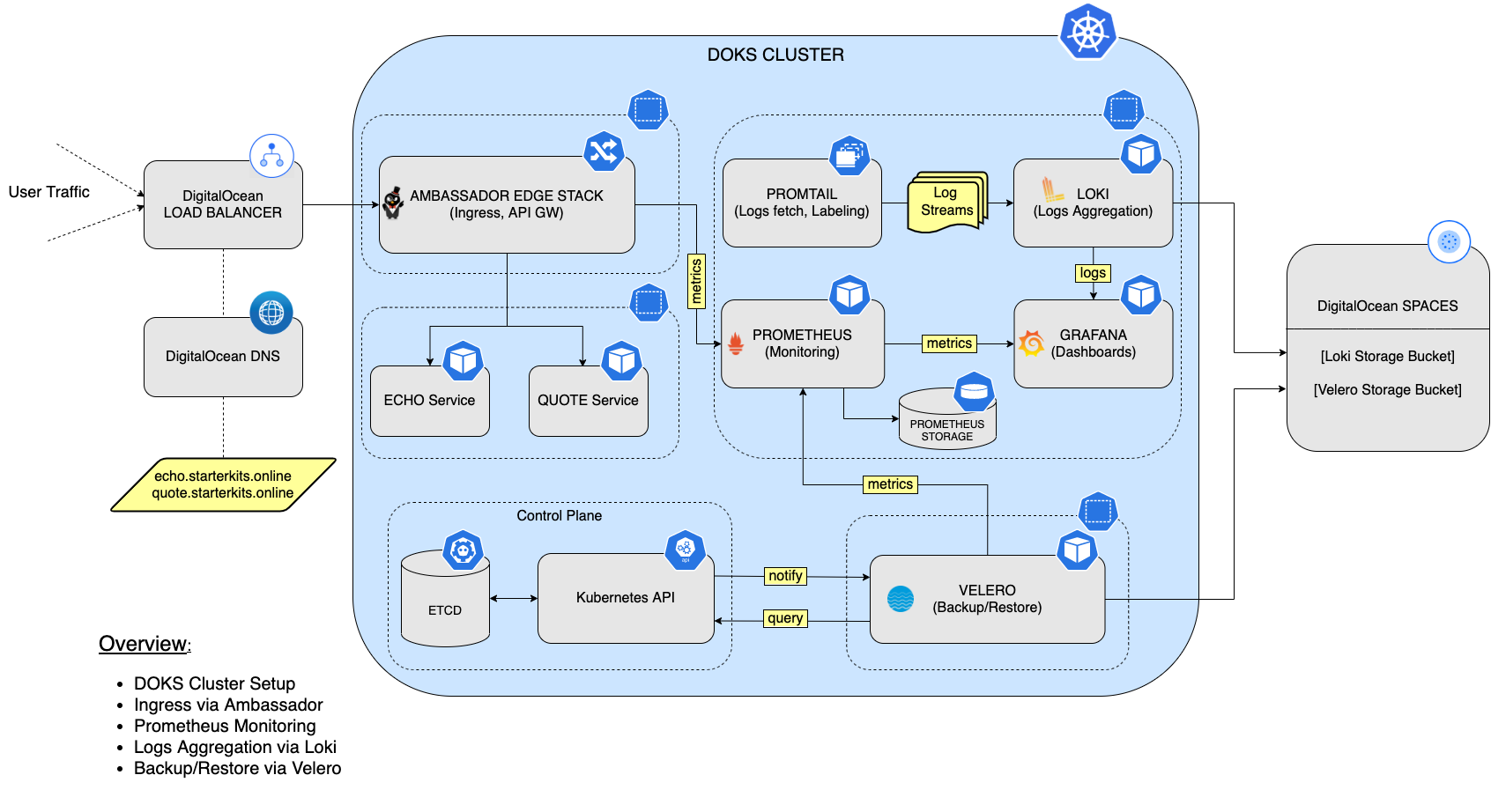Day-2 Operations-ready DigitalOcean Kubernetes (DOKS) for Developers
In this tutorial, we provide developers a hands-on introduction on how to get started with an operations-ready Kubernetes cluster on DigitalOcean Kubernetes (DOKS). Kubernetes is easy to set up and developers can use identical tooling and configurations across any cloud. Making Kubernetes operationally ready requires a few more tools to be set up, which are described in this tutorial.
Resources used by the starter kit include the following:
- DigitalOcean
Droplets(forDOKScluster). - DigitalOcean
Load Balancer. - DigitalOcean
Block Storagefor persistent storage. - DigitalOcean
Spacesfor object storage.
Remember to verify and delete the resources at the end of the tutorial, if you no longer need those.
Operations-ready Setup Overview
Below is a diagram that gives a high-level overview of the Starter Kit setup, as well as the main steps:
Table of contents
- Scope
- Set up DO Kubernetes
- Set up DO Container Registry
- Ingress Using Ambassador
- Prometheus Monitoring Stack
- Logs Aggregation via Loki Stack
- Backup Using Velero
- Alerts and Notifications
- Kubernetes Sealed Secrets
- Estimate resource usage of starter kit
- Automate Everything Using Terraform and Flux
Scope
This tutorial demonstrates the basic setup you need to be operations-ready.
All the steps are done manually using the command line interface (CLI). If you need end-to-end automation, refer to the last section.
None of the installed tools are exposed using Ingress or Load Balancer. To access the console for individual tools, we use kubectl port-forward.
We will use brew (on MacOS) to install the required command-line utilities on our local machine and use the command to work on a DOKS cluster.
For every service that gets deployed, we will enable metrics and logs. At the end, we will review the overhead from all these additional tools and services. That gives an idea of what it takes to be operations-ready after your first cluster install.
This tutorial will use manifest files from this repo. It is recommended to clone this repository to your local environment. The below command can be used to clone this repository.
git clone https://github.com/digitalocean/Kubernetes-Starter-Kit-Developers.git
git checkout <BRANCH> # If you want to pick a tested branch corresponding to DOKS release, eg. 1.21Notes:
- Main branch should generally work. Just note that it is being frquently updated. If you want to be safe, pick a specific branch corresponding to DOKS release (eg. 1.21).
- For this
Starter Kit, we recommend to start with a node pool of higher capacity nodes (say,4cpu/8gb RAM) and have at least2nodes. Otherwise, review and allocate node capacity if you run into pods inPENDINGstate. - We customize the value files for
Helminstalls of individual components. To get the original value file, usehelm show values. For example:helm show values prometheus-community/kube-prometheus-stack --version 17.1.3. - There are multiple places where you will change a manifest file to include a secret token for your cluster. Please be mindful of
handlingthesecrets, and do notcommittopublic Gitrepositories. A safer method to use isSealed Secrets, explained in Kubernetes Sealed Secrets. The sample manifests provided in the Automate Everything Using Terraform and Flux section, shows you how to useSealed Secretsin combination withFlux CD, and referencesensitivedata in each manifest that require secrets. - For the final automation, the GitHub
repository(andbranch) must be created beforehand - the DigitalOcean Terraform module used in this tutorial doesn't provision one for you automatically.
If you want to automate installation for all the components, refer to Section 15 - Automate with Terraform & Flux CD.
